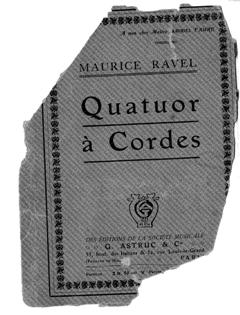Marice Ravel: Violin Sonata No.2 – String Quartet in F major
Marice Ravel: Violin Sonata No.2 – String Quartet in F major

Violin Sonata No. 2 1. Allegretto 2. Blues. Moderato 3. Perpetuum mobile. Allegro Lyana Ysakadze – violin Vlagimir Skanabi – piano, 1968 String Quartet in F major 4. I. Allegro moderato – Très doux 5. II. Assez vif – Très rythmé 6. III. Très lent 7. IV. Vif et agité Emerson String Quartet, 1995
Ravel's Sonata for violin and piano (1923-1927) at once illustrates the composer's singular sense of instrumental color in its successful exaggeration of the differences between the violin and the piano. The Sonata's genesis was interrupted by several other compositions; their imprint is evident in the work's mixture of styles, from the blues idiom of the second movement to the perpetuum mobile finale.
Ravel felt that the violin and piano are essentially incompatible instruments, and he exploits something of this friction throughout the first movement. While a gentle lyricism pervades this Allegretto, it is frequently contrasted with sharp, angular themes and highly independent part-writing. An extended cantabile passage for the violin, superimposed over the first two themes, arrives near the end of the movement, which concludes with a three-voice fugato.
While the "Blues" movement predates Ravel's trip to the United States in 1928, the composer commented on it in the course of his visit: "To my mind, the 'blues' is one of your greatest musical assets, truly American despite earlier contributory influences from Africa and Spain. Musicians have asked me how I came to write 'blues' as the second movement of my recently completed sonata for violin and piano.... While I adopted this popular form of your music, I venture to say that nevertheless it is French music, Ravel's music, that I have written. Indeed, these popular forms are but the materials of construction, and the work of art appears only on mature conception where no detail has been left to chance."
Ravel's adoption of the blues idiom is characteristicallly stylized through the addition of bitonality and timbral enrichment, though elements from "pure" jazz, such as the use of the flatted seventh and syncopated rhythms, are also prevalent. The influence of jazz upon the composer would later be more fully manifested in his two piano concerti.
In the third movement, an Allegro perpetuum mobile, the brilliance of the violin writing is contrasted with the relative simplicity of the accompaniment. The musical discourse includes thematic references to the preceding two movements, and an abbreviated reprise of the finale's opening material is underpinned by a theme from "Blues." --- Brian Wise, Rovi
The similarities between Maurice Ravel's only work for string quartet, the String Quartet in F major, and Claude Debussy's only work for string quartet, the String Quartet in G minor, Op. 10, can hardly be avoided or ignored. During the early years of his career, Ravel was frequently and sometimes vehemently criticized for having copied Debussy, and it was only later that musical society began to realize that, in the realm of piano music at least, it was equally possible that Debussy had imitated his younger colleague. With the String Quartet in F, composed in 1902 and 1903 and then revised up to 1910, however, Ravel seems more certain to have relied on Debussy's 1893 Op. 10; as emotionally, psychologically, and even structurally different as the two works are, one could never accuse them of having a language barrier. But, whereas Debussy's quartet is the work of a headstrong progressive still on his way to developing a mature, personal style, Ravel's is the work of an already mature artist more concerned with craftsmanship and traditional structure than with innovation. Not surprisingly, given their relative places in their careers when the two composers wrote their string quartets, Ravel's is the more sound piece of music and Debussy's is the more groundbreaking. Incidentally, Debussy, by all accounts, adored Ravel's piece, and though it makes the cut by just a couple of years, it is probably the most oft-played string quartet of the twentieth century. Ravel dedicated it to his teacher, Gabriel Fauré.
Ravel's String Quartet is in four movements: Moderato très doux, Assez vif-Très rythmé, Très lent, and Vif et agité. The opening movement's pianissimo second theme is as hollow and melancholy as the first theme is warm and inviting. In the second movement, which serves as the Quartet's scherzo, Ravel moves into the pizzicato world already explored by Debussy in the scherzo movement of his String Quartet; the central portion (one hesitates to call it a "trio section") calls for the players to put mutes on their instruments. Bits of music from earlier in the Quartet can be heard, wearing new clothes, in the slow movement; likewise in the finale, which plunges straight into a frantic 5/4 meter bombast at its start, lightens up in the middle, and then ends in a blaze of zeal. --- Blair Johnston, Rovi
download: uploaded yandex 4shared mediafire solidfiles mega filecloudio nornar anonfiles ziddu
Last Updated (Wednesday, 02 April 2014 15:03)








